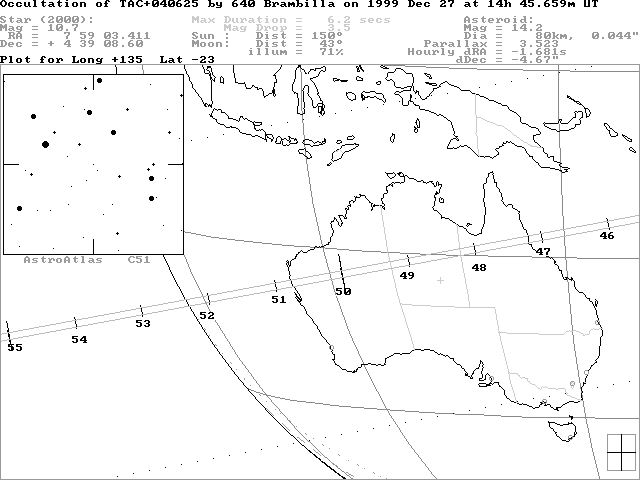ASTROMETRIC UPDATE:
OCCULTATION BY (640) BRAMBILLA - 1999 DECEMBER 27
CHECK THIS PAGE REGULARLY FOR FURTHER UPDATES AND CHANGES TO THE TRACK.
YOU MUST RELOAD THIS PAGE USING YOUR BROWSER'S
RELOAD/REFRESH BUTTON TO OBTAIN UPDATES!
[Prediction by Edwin Goffin]
[Prediction using OCCULT software]
Goffin's predicted path crosses southern Australia passing near Canberra and to the south of Adelaide. The OCCULT predicted path crosses northern Australia from Iron Range on the Cape York Peninsula through to Derby in the Kimberleys.
UPDATE: 22 December 1999
This prediction update has been computed by Stephen Kerr based on astrometry from Ron Stone at the US Naval Observatory - Flagstaff Station. The TAC position of the target star has been used.
Summary:
The update suggests a shift of about 1" to the north and 130 seconds earlier than Goffin's path and 0.3" or around 5 path-widths to the south of the OCCULT generated path. The updated path crosses the north Queensland coast around Tully (14:47:15 UTC) , passes near Barrow Creek in the Northern Territory (14:48:40 UTC) and just to the north of Carnarvon on the Western Australian coast (14:50:45 UTC).
While the uncertainties in the target star position are not strictly known by the author, the TAC catalog is known to be of only moderate accuracy and the updated path should therefore not be taken as being absolutely accurate.
THE EVENT AT ONE GLIMPSE:
- Date and approx. UT time of event: December 27, 1999 @ 14:47 UT
- Magnitude of target star: 10.7
- Magnitude drop [mag]: 3.6
- Estimated maximum duration [s]: 6.6
- Path description: See above.
The Occultation Path:
- Approximate width [km]: 90 km
Data for the target star:
- Name: TAC +04o06250 = GSC 189 1016
- Constellation: Canis Minor
- J2000 position [h,m,s; o,',"]: 07h 59m 03.441s; +04o 39' 08.60"
- Position source: TAC
- V mag [mag]: 10.7
- The target star is in eastern Canis Minor. The 5.6 mag star HD 65900 lies around 36' to the east-north east.
Data for the minor planet:
- Number, name: (649) Brambilla
- Approx. diameter [km]: 84.8
- Source of used astrometry: USNO-Flagstaff (Ron Stone)
- Number of used observations: 6
- Number of rejected observations: 0
- Time covered by the observations: 1999 12 05 to 1999 12 17
Data for the event:
- UT date and time of least geocentric approach: 14:45.7 UT
- Approx. V mag of minor planet at event [mag]: 14.2
- Geocentric parallax of minor planet ["]: 3.52
- Magnitude drop [mag]: 3.6
- Estimated maximum duration [s]: 6.6
- Apparent motion of minor planet ["/h]: 25.57
- Angular distance to moon, phase of moon [deg,%]: 44, 70%
- Update computed by: Kerr (OCCULT 4.2)

IMPORTANT NOTE!
Astrometric updates such as these should not be taken as definitive, but rather only as an indication of where the true track may lie relative to the original predicted track. Observers must bear in mind that later astrometry, in which the target star is measured in the same field as the asteroid, may still reveal substantial changes to the predicted track and time of the event. For this reason it is most important that observers far from the predicted track still monitor the event.
Use these links for further information:
[Planetary Occultations]
[Using the Predictions]
[Observing Details]
[Timing Details]
[Reporting Details]
[Report Form]
[Asteroid Occultation Results]
This page may have been updated since 22 December 1999.
Hit your browser's RELOAD button to get the latest version.
[Site Map]
[What's an Occultation?]
[Total Occultations]
[Grazing Occultations]
[Planetary Occultations]
[Jovian Satellite Eclipses]
[Timing Occultations]
[Reporting Observations]
[Coming Events]
[Software]
[About Us]
[Publications]
[Membership]
[Links]
[Top of Page][Return to Home Page]
